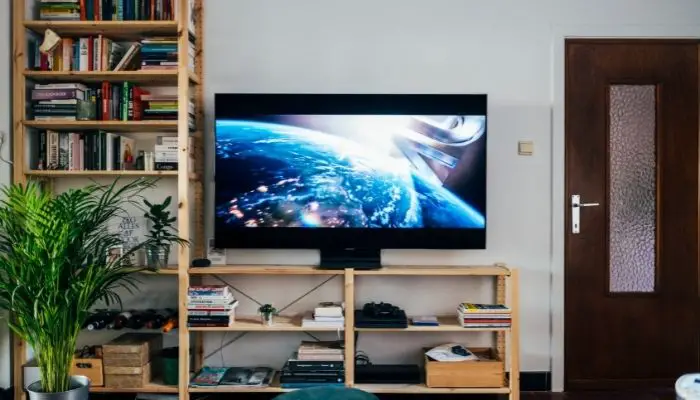TV and multimedia devices have become an integral part of our daily lives. A few houses do not have a television, CD or DVD player, or any other type of media player. Furthermore, the power consumption of each of these gadgets can be determined.
A specified number of electricity Amps is consumed by each multimedia device. TVs are no longer used solely for “viewing a TV.” They are used for various purposes, including media streaming, gaming, communication, and security; that’s why most people consider it is essential to know How Many Amps Does a TV Use?
Unlike LCD televisions of the past, modern Smart TVs are more energy-efficient. They’re fun to watch, but they also come with a slew of energy-saving features. It can be challenging to estimate the exact wattage, mainly if you frequently use many devices simultaneously. There is a method available for determining the current draw of your television set in Amps to your good fortune.
What Do You Mean by the Term “Amps”?
Conventional units of measurement for electricity are Amps, abbreviated as Amperes. Amperage, on the other hand, measures the current’s strength. You can measure electrical current in amps. As a result, you’ll need to utilize Amps to figure out how much electricity you’re using.
Using your circuit breaker, you may determine how many amps your home is drawing. Circuit breakers are switches installed in electrical circuits to prevent them from being damaged. A short circuit or an overcharge might cause this damage. Its primary purpose is to control the flow of current in an electrical malfunction.
Your circuit breaker must be able to supply your home with energy if it has a stated Amperage. Check the circuit breaker lever if you want to know your home’s Amperage. About 15 to 20 Amps are typical for a typical domestic circuit breaker. Amperage is typically higher in modern houses. In any case, knowing how many Amps your devices draw is a good idea.
Easy Way to Calculate Amps
It would help if you did the following to arrive at an accurate estimate of the number of amps your television draws:
Step 1: You need to know the amperage rating of your circuit breaker first.
Step 2: The next step is to consult the label or manual that came with your television set to determine the number of watts and volts that the television will require.
Step 3: Divide the total number of watts by the total number of volts to get the answer.
Step 4: The outcome will be the maximum number of amperes that your television will use from your circuit.
How Much Power Does a Television Consume?
TVs typically utilize 50 to 200 watts of electricity, depending on the model. One amp is all that most TVs need to be connected to any 120-volt outlet without any issues whatsoever.
The amount of time you spend watching television has the most significant impact on the amount of electricity your television consumes over time. As it turns out, Americans are watching less television these days, with an average daily viewing time of three hours.
For Example
Using a 100-watt TV as an example:
For 1.5 Hour
It takes 1.05 kilowatt-hours (kWh) of electricity every week, 4.55 kWh per month, and 54.6 kWh per year to watch 1.5 hours of television.
For 2 Hours
An average week’s worth of electricity is equivalent to just under two-kilowatt hours (kWh). A month’s worth of electricity is about a nine-kilowatt hour (kWh).
For 4.5 Hours
It takes 3.15 kWh a week to run 100 W TV for 4.5 hours per day, which adds up to 13.65 kWh monthly and 163.8 kWh annually.
During a year, different wattage televisions use a varying amount of electricity.
Power Consumption of Most Modern TVs

Some ordinary TVs are mentioned below to know How Many Amps Does a TV Use?
By A 50-inch TV
When powered by 120 volts, the typical 50-inch TV in the United States uses 0.95 amps. So, a standard TV uses 113 watts of electricity. The average TV consumes 142 kWh and costs about $17 in electricity in a year (assuming 5 hours per day).
A 65-inch Smart TV
The power company converts 1.0 amps per hour (kWh) into kilowatts per hour (kW) to compute your monthly electricity bill.
By a 46-inch Micro Display
A 46-inch micro display requires 0.13(906)/120=0.9815 amps, or less than half the amps needed to run a plasma television. A micro display rear projector’s television uses the least electricity at 0.11 to 0.15 watts per square inch. It is said that LED televisions use only one-fourth of the power of plasma televisions, making them even more energy efficient.
By 60-inch Smart TV
A 60-inch Samsung TV draws how many amps? An average 60-inch model draws 2.4 amps, compared to 2.4 amps for the 42-inch size. Depending on your machine’s resolution and other characteristics, this may vary significantly, but in general, it shouldn’t go above three amps altogether.
By a Plasma TV
A television’s power consumption is dependent on its size and kind. Plasma televisions are the most efficient power consumption per square inch, whereas micro displays are the least efficient. With a viewing area of 906 square inches, a 46-inch plasma requires.
Thirty and.39 watts per square inch of power. A current of 2.6425 amps equals 0.35(906)/120 watts, which is the wattage divided by the Voltage. 2.6425 amps are required for a plasma TV.
By a 46-inch LCD
If you’re looking for a 46-inch LCD television, you’ll need to use between 1.208 and 3.1 amps, depending on the model. Televisions with cathode-ray tubes have a power consumption rate of 1.8875 to 3.02 amps for a 46-inch screen, making them potentially more energy-efficient.
A Comparison of Amps Concerning Current TV Screen Technologies
Most televisions include a sticker or user manual that specifies the wattage and voltage requirements. OLED, LCD, LED, QLED, etc. are currently the most prevalent TV screen technology; plasma screens and specifically CRT (Cathode Ray Tube) screens are becoming obsolete.
It takes 1 amp to power on a standard flat-screen television, but a Smart TV consumes 1 amp each hour. In addition, it needs around 1.67 Amps to operate an old Plasma television, while 0.83 Amps are required to run an LCD television of the same size. A 40-inch panel LED television uses approximately 0.42 Amps, while a 40-inch OLED television uses about 0.6 Amps.
For example, a 50-inch television will consume approximately 200 watts of power. Thus, if you connect your television to 120V, you will need about 1.6 Amps. Note that the more Voltage your television requires, the less Amperage it will use.
How to Decrease the Amount of Energy Consumed by Your Television?
Following is the prevention that you can follow to reduce power usage by your TV:
Look for the Energy Star label
Smart TVs with the Energy Star badge are becoming more commonplace these days. Power usage is significantly reduced with a higher star rating. The quality is also unchanged. But the television is designed to save energy.
Unplug It While Not in Use
Even when the TV is switched off or in standby mode, it continues to draw power. Unplugging the TV or turning off the power strip can be done while the TV is not used. When the TV isn’t being used, it won’t be consuming energy that could be better spent elsewhere.
Check Contrast
Contrast, like brightness, affects power consumption. Achieve a level of comparison that is acceptable. Even you can achieve a 20% reduction in power usage with the proper combination of brightness and contrast.
Dim the Brightness
Brightness/contrast is the most critical TV setting regarding energy use. The more power your TV uses and the more money you’ll spend on electricity, your TV will be brighter.
Activate the Energy-Saving Mode.
Some TVs have a power-saving mode that you should activate if yours does. The TV’s brightness can be automatically adjusted to provide the best viewing experience while also saving energy.
Mute the Sound
Additionally, you may wish to lower the TV volume or mute it while commercials are playing. It is unnecessary to waste electricity on sound when you’re not even watching the television. Quiet time could be precisely what you need!
Use Sleep Timer
Finally, take a look at the programmable timer option (sleep timer). It is ideal for those who are prone to nodding off in the middle of a movie or television show, thereby causing the TV to remain on all night. It will automatically turn itself off if you set a sleep timer on your TV.
Factors That Affect the Cost of Television Power
Following are the factors you should consider to know How Many Amps Does a TV Use?
- The assumption that you will watch a TV for five hours a day is used to calculate all associated energy expenditures. You will pay more or less based on how much time you spend watching television. Even if you watch TV for ten hours a day, you’ll still pay $100 a year for it.
- According to where you reside and whether you have solar or other renewable energy sources, your electricity costs will vary greatly. Calculations for the energy guide assume a rate of 11 cents per kWh. Prices may be cheaper or more depending on your situation. For example, my score is higher than most.
- The contrast, power conservation mode, sleep timer, brightness, and can all increase your TV’s power consumption.
- Reducing your device’s power consumption is easy with the power saving mode and the automatic sleep timer. It’s going to save a lot of money on electricity.
- When you’re ready for bed, set the sleep timer to turn off the TV, and use the power saving option to save even more power.
Frequently Asked Question
How Many Amps Does a TV Use Per Hour?
US TVs feature a 50-inch screen and draw 0.95 amps at 120 volts. The average TV uses 112 watts, according to this formula. The average TV uses 142 kWh of electricity per year and costs $17, assuming 5 hours of use per day.
Does a Bigger TV Use More Electricity?
The larger the screen, the more power it needs. Despite getting bigger, TVs have grown more energy-efficient. The type of screen also matters. CRTs and plasma panels use as much energy as employing LCDs and LEDs.
How Many Amps Does a 40 Inch Smart TV Use?
OLED TVs use 0.6 amps compared to 0.42 amps for LED TVs. 50-inch TVs require 200 watts on average. If you’re utilizing a 120V outlet, you’ll need 1.
Conclusion
When compared to earlier TV models, Smart TVs often use less power. LED televisions are the most energy-efficient, followed by LCD televisions. Plasma TVs use more power than any other type of television. Aside from that, larger TVs use more energy in watts and amps.
You can find most of the information you’re looking for in this post. Companies that don’t include the Amperage utilized by their electronic equipment on their labels can be highly frustrating.

